#Diagnostic Materials
Explore tagged Tumblr posts
Text
IVD Raw Materials: Ensuring Quality Control From Procurement to Production
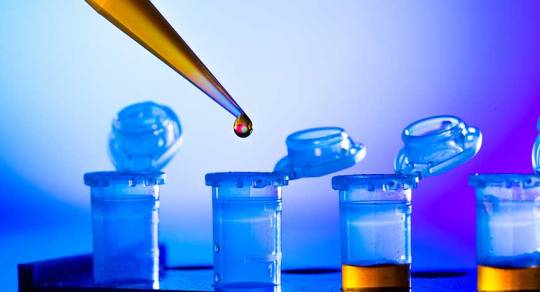
Raw Material Procurement and Quality Testing The procurement of quality raw materials is the first and crucial step in the production of in vitro diagnostic devices. Various materials like reagents, antigens, antibodies, polymers and minerals are required as raw inputs. To ensure only materials meeting stringent specifications are procured, suppliers undergo a rigorous qualification and audit process.
Critical parameters like purity, potency, IVD Raw Materials ��composition and contamination levels are evaluated. Certificates of analysis are reviewed to check if the raw material meets pre-defined acceptance criteria. Periodic re-qualification of suppliers is done to verify they maintain consistent quality over time.
Random sampling and testing is conducted on incoming raw material shipments. Tests include identity verification, quantitative analysis, bioburden screening, endotoxin checks and validation of sterile filtration for heat sensitive components. Any deviations from specifications warrant an investigation and corrective actions before material acceptance. Comprehensive documentation and traceability is maintained for all incoming raw lots.
IVD Raw Materials Storage and Stability Monitoring After acceptance, raw materials are stored as per labeled storage requirements - some may need refrigeration or freezing, while others can be kept at ambient conditions. Designated quarantine and warehouse areas ensure proper segregation.
Environmental conditions of storage areas are continually monitored and recorded to confirm maintenance of set limits. Periodic reviews check for any excursions, equipment breakdowns or process deviations that could impact material stability.
Regular stability monitoring programs assess critical quality attributes of stored raw materials over time. Tests help prove labeled shelf-life or re-test periods and validate that materials maintain suitability for production throughout their intended lifespan. Out-of-specification results prompt corrective measures including rejection or re-processing.
Raw Material Change Control Minor modifications to approved supplier sites, transportation routes or raw material specifications require review and approval to address any potential quality impacts.
Significant changes warrant additional verification activities like method validation, real time and accelerated stability studies on materials manufactured using the changed process. Comparability assessments prove no adverse changes to performance, safety or effectiveness.
Only after successful change validation are revised materials released for commercial production. Rigorous change control safeguards maintain consistent quality of inputs vital for finished product quality and reliability.
Raw Material Quality in the Manufacturing Process Raw material quality directly influences finished product quality. Manufacturing processes are validated to demonstrate robustness even for slight input variability. In-process checks monitor critical parameters.
Materials are properly identified at all stages and batch records capture complete traceability. Environmental controls of manufacturing areas are maintained within pre-set action limits. Cross contamination prevention strategies are in place.
Process simulators and real time release testing help detect early if any raw material deviation may lead to failure to meet pre-defined acceptance criteria for the produced medical devices. Out of specification results trigger investigations.
IVD Raw Materials Related Nonconformities Despite preventive controls, raw material or supplier nonconformities sometimes arise necessitating containment actions. Impacted lots are immediately quarantined and prevented from further use.
Root cause analysis determines corrective measures and extent of trace forward and backward impact on finished devices. Possible device recalls are evaluated if patient safety could be compromised. Lessons learned help strengthen procurement and control strategies.
An effective raw material management system supported by science-based quality oversight enables consistent production of safe and effective IVD products. Continuous improvement further enhances the reliability of this critical first link in the diagnostic device value chain. Get More Insights On, IVD Raw Materials For More Insights Discover the Report In language that Resonates with you
French
German
Italian
Russian
Japanese
Chinese
Korean
Portuguese
About Author: Priya Pandey is a dynamic and passionate editor with over three years of expertise in content editing and proofreading. Holding a bachelor's degree in biotechnology, Priya has a knack for making the content engaging. Her diverse portfolio includes editing documents across different industries, including food and beverages, information and technology, healthcare, chemical and materials, etc. Priya's meticulous attention to detail and commitment to excellence make her an invaluable asset in the world of content creation and refinement.(LinkedIn- https://www.linkedin.com/in/priya-pandey-8417a8173/)
#IVD Raw Materials#Diagnostic Materials#Laboratory Supplies#Biomedical Science#Diagnostic Reagents#Raw Materials
0 notes
Text
(Before Ray diagnostics test)
Groupmate: Did you study?
Me: I did:)
Groupmate: Great!
Me: For the microbiology practical exam:) We have right after this:)
Groupmate: oh.
Groupmate: Oh.
#for context: practical exam is 47 reactions you have to know by heart#and by 'reactions' I mean 'multi step diagnostics methods'#and we're coming right off of a module control which had the equivalent of exam materials of information and left everyone exhausted#I had three separate mental breakdowns last night trying to study because my nervous system was exhausted and the words just didn't. fit.#i know the first twenty well and some of the later ones but that's not nearly enough and we're taking it with our prof which is worse than#the rest of them (other groups get help because stressed med students+ anthrax is not a good combo) and we won't#finals#pre finals#i wanna die#med student#medical school#med school shenanigans
6 notes
·
View notes
Text
light yagami does not have npd or aspd but yall are not ready to discuss this yet
#pls think critically abt the source material#and the diagnostic criteria#its just the demonisation of cluster b disorders as usual#’hes evil it must be a cluster b disorder’ for the love of god
7 notes
·
View notes
Text
the mmpi-3 is so infuriating. why do i have to take this 335 question assessment when every question is like "i have had very peculiar and strange experiences" ???? i was medically gaslit for 28 years and was literally hours from death at one point because my pain tolerance is so high. i was taken to a nudist colony by my mother at the age of 6. do those count? or are you asking me if i have delusions
#i'm typing up my rationale for each response to review with my doctor and a lot of it is just 'idk what this is asking'#'here are all of the things this question could mean. i'm going with interpretation X'#more autistic people writing diagnostic materials PLEASE
1 note
·
View note
Text
WHY DO THESE THINGS ALWAYS HAPPEN TO ME!!!!!
#I have a bilingual diagnostic for a baby 2 year old on Friday#and my supervisor told us to prepare the PLS-5 spanish assessment#speaking as if we HAD that assessment in the materials center#so we are trusting her and taking her word for it#obviously someone has done it in the clinic before#so today i grab all the assessment forms for Friday for my partner and I#and there’s no Spanish forms#so im like ummmm okay#I tell my partner and we are searching high and low for this assessment#we even ask our clinic director#TURNS OUT THE DAMN ASSESSMENT ISNT EVEN ON FILE IN THE CLINIC!!!!!!#like girl !!!!!#i am🙃🙃🙃🙃🙃#so stressed#this is gonna be the most informal diagnostic which makes writing the report even harder#i need to be done so bad#im just so burnt out and things like this don’t help#HALDLWOFHAMDNNAMDKQJFNMQKD#anywayssssss#em’s brain dump
3 notes
·
View notes
Text
What Is Microfluidics? An Introduction to Lab-on-Chip Technology
Discover how microfluidics and Lab-on-Chip technology are revolutionising diagnostics, research, and environmental monitoring. Learn about their precision, cost-effectiveness, and applications in healthcare, genomics, and food safety. Bring innovation to your business with cutting-edge solutions today.
#microfluidics technology#lab-on-chip devices#portable diagnostics#microfluidic applications UK#lab-on-chip healthcare#microfluidics environmental monitoring#microfluidics DNA analysis#microfluidic cost-effective testing#advanced lab-on-chip solutions#microfluidics sustainability#microfluidic drug development#LOC portable testing devices#A-Gas Electronic Materials
0 notes
Text
Meharry Medical College and Global Partners Build Largest African Ancestry Genomic Database
Meharry Medical College, in collaboration with Regeneron Genetics Center, AstraZeneca, Novo Nordisk, and Roche, has launched an initiative to create the world’s largest genomic database of individuals with African ancestry. The project aims to collect genetic material from 500,000 participants to develop a new reference genome that better represents Black populations, potentially leading to…
#African ancestry#anonymous data#AstraZeneca#diagnostic tests#Diaspora Human Genomics Institute#genetic material#genetic research#genomic database#grant program.#HBCUs#health disparities#medicine development#Meharry Medical College#Novo Nordisk#pharmaceutical companies#reference genome#Regeneron Genetics Center#research collaboration#Roche#STEM education#underrepresentation
0 notes
Text
Chemists use dinitrogen from air to form critical bonds for energy-efficient industrial synthesis
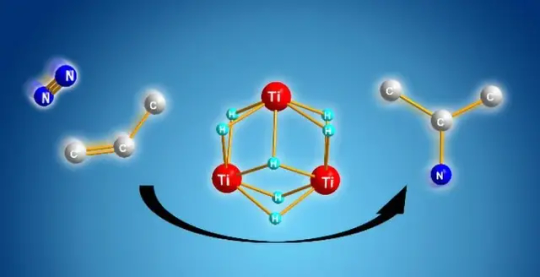
- By Nuadox Crew -
Chemists at RIKEN have demonstrated that dinitrogen (N₂), a highly abundant molecule in the atmosphere, can be directly used to form a crucial chemical bond, potentially making industrial synthesis of compounds like polymers and drugs more energy-efficient.
Though N₂ is readily available, its strong triple bond makes it difficult to use in chemical reactions. Traditionally, processes like the Haber–Bosch method are required to split dinitrogen into ammonia, followed by additional steps that consume energy and time.
To address this, Takanori Shima and his team discovered that titanium polyhydrides—compounds with titanium and hydrogen atoms—can cooperatively facilitate the formation of alkyl amines from N₂ and alkenes. This method bypasses the need for pre-activated intermediates, activating both substrates and selectively forming nitrogen-carbon bonds.
This breakthrough could streamline chemical synthesis processes, and the team is now working to develop it into a catalytic process.
Header image: Titanium polyhydride (center) directly transforms dinitrogen and a basic alkene (left) into an alkyl amine (right). Credit: Takanori Shima.
Read more at RIKEN
Scientific paper: Shima, T., Zhuo, Q., Zhou, X., Wu, P., Owada, R., Luo, G. & Hou, Z. Hydroamination of alkenes with dinitrogen and titanium polyhydrides. Nature 632, 307–312 (2024). doi: 10.1038/s41586-024-07694-5
--
Other recent news
Radiology: A new portable scanner quickly produces 3D images, aiding in early diagnosis.
#chemistry#materials#synthesis#polymers#pharma#diagnostics#imaging#3d#radiology#medtech#mobile health#air
0 notes
Text
Plant sensors could act as an early warning system for farmers
New Post has been published on https://thedigitalinsider.com/plant-sensors-could-act-as-an-early-warning-system-for-farmers/
Plant sensors could act as an early warning system for farmers
Using a pair of sensors made from carbon nanotubes, researchers from MIT and the Singapore-MIT Alliance for Research and Technology (SMART) have discovered signals that reveal when plans are experiencing stresses such as heat, light, or attack from insects or bacteria.
The sensors detect two signaling molecules that plants use to coordinate their response to stress: hydrogen peroxide and salicylic acid (a molecule similar to aspirin). The researchers found that plants produce these molecules at different timepoints for each type of stress, creating distinctive patterns that could serve as an early warning system.
Farmers could use these sensors to monitor potential threats to their crops, allowing them to intervene before the crops are lost, the researchers say.
“What we found is that these two sensors together can tell the user exactly what kind of stress the plant is undergoing. Inside the plant, in real time, you get chemical changes that rise and fall, and each one serves as a fingerprint of a different stress,” says Michael Strano, the Carbon P. Dubbs Professor of Chemical Engineering at MIT and one of the senior authors of the study.
Sarojam Rajani, a senior principal investigator at the Temasek Life Sciences Laboratory in Singapore, is also a senior author of the paper, which appears in Nature Communications. The paper’s lead authors are Mervin Chun-Yi Ang, associate scientific director at SMART and Jolly Madathiparambil Saju, a research officer at Temasek Life Sciences Laboratory.
Sensing stress
Plants respond to different kinds of stress in different ways. In 2020, Strano’s lab developed a sensor that can detect hydrogen peroxide, which plant cells use as a distress signal when they are under attack from insects or encounter other stresses such as bacterial infection or too much light.
These sensors consist of tiny carbon nanotubes wrapped in polymers. By changing the three-dimensional structure of the polymers, the sensors can be tailored to detect different molecules, giving off a fluorescent signal when the target is present. For the new study, the researchers used this approach to develop a sensor that can detect salicylic acid, a molecule that is involved in regulating many aspects of plant growth, development, and response to stress.
To embed the nanosensors into plants, the researchers dissolve them in a solution, which is then applied to the underside of a plant leaf. The sensors can enter leaves through pores called stomata and take up residence in the mesophyll — the layer where most photosynthesis takes place. When a sensor is activated, the signal can be easily detecting using an infrared camera.
The pair of sensors in the leaf consists of one for hydrogen peroxide on the left, and salicylic on the right. When the plant is wounded, as in this case, the left shows a moving waveform in response, but there is very little production of salicylic acid. This is the stress signature of wounding. In contrast, when the plant is stressed by too much heat or light, or a bacterial infection, different waveforms of salicylic acid accompany of the hydrogen peroxide wave on the left.
Image: Courtesy of the researchers
In this study, the researchers applied the sensors for hydrogen peroxide and salicylic acid to pak choi, a leafy green vegetable also known as bok choy or Chinese cabbage. Then, they exposed the plants to four different types of stress — heat, intense light, insect bites, and bacterial infection — and found that the plants generated distinctive responses to each type of stress.
Each type of stress led the plants to produce hydrogen peroxide within minutes, reaching maximum levels within an hour and then returning to normal. Heat, light, and bacterial infection all provoked salicylic acid production within two hours of the stimulus, but at distinct time points. Insect bites did not stimulate salicylic acid production at all.
The findings represent a “language” that plants use to coordinate their response to stress, Strano says. The hydrogen peroxide and salicylic acid waves trigger additional responses that help a plant survive whatever type of stress it’s facing.
For a stress such as an insect bite, this response includes the production of chemical compounds that insects don’t like, driving them away from the plant. Salicylic acid and hydrogen peroxide can also activate signaling pathways that turn on the production of proteins that help plants respond to heat and other stresses.
“Plants don’t have a brain, they don’t have a central nervous system, but they evolved to send different mixtures of chemicals, and that’s how they communicate to the rest of the plant that it’s getting too hot, or an insect predator is attacking,” Strano says.
Early warning
This technique is the first that can obtain real-time information from a plant, and the only one that can be applied to nearly any plant. Most existing sensors consist of fluorescent proteins that must be genetically engineered into a specific type of plant, such as tobacco or the common experimental plant Arabidopsis thaliana, and can’t be universally applied.
The researchers are now adapting these sensors to create sentinel plants that could be monitored to give farmers a much earlier warning when their crops are under stress. When plants don’t have enough water, for example, they eventually begin to turn brown, but by the time that happens, it’s usually too late to intervene.
“With climate change and the increasing population, there is a great need to understand better how plants respond and acclimate to stress, and also to engineer plants that are more tolerant to stress. The work reveals the interplay between H2O2, one of the most important reactive oxygen species in plants, and the hormone salicylic acid, which is widely involved in plants’ stress responses, therefore contributing to the mechanistic understanding of plants stress signaling,” says Eleni Stavrinidou, a senior associate professor of bioengineering at Linköping University in Sweden, who was not involved in the research.
This technology could also be used to develop systems that not only sense when plants are in distress but would also trigger a response such as altering the temperature or the amount of light in a greenhouse.
“We’re incorporating this technology into diagnostics that can give farmers real-time information much faster than any other sensor can, and fast enough for them to intervene,” Strano says.
The researchers are also developing sensors that could be used to detect other plant signaling molecules, in hopes of learning more about their responses to stress and other stimuli.
The research was funded by the National Research Foundation of Singapore and the USDA National Institute of Food and Agriculture.
#agriculture#approach#Bacteria#bioengineering#Brain#carbon#Carbon materials#carbon nanotubes#Cells#change#chemical#chemical compounds#Chemical engineering#chemicals#climate#climate change#communications#crops#development#diagnostics#Engineer#engineering#experimental#fingerprint#Food#Foundation#Giving#green#greenhouse#growth
0 notes
Text

Empower your heavy equipment diagnostics with Mechnician's Jaltest Heavy Equipment Diagnostic Laptop. Engineered for precision, this portable powerhouse ensures comprehensive analysis and efficient troubleshooting. Stay ahead in the heavy equipment industry with Mechnician's innovative solution, delivering reliability and accuracy in every Diagnostic session.
0 notes
Text
I keep telling my mom she probs has mild ADHD and she says “well I wasn’t diagnosed when I was little so no I don’t” ma’am you grew up in the 60s. Ofc you wouldn’t be diagnosed back then unless you were an extremely obvious case. And then she says “well I only have trouble paying attention to something if it doesn’t interest me. If it interests me I can pay attention really well” like you literally just described ADHD!!!
#she doesn’t go by diagnostic criteria. she goes by what she hears on the news in 80s for both autism and adhd#and my dad’s almost non-verbal brothers and non-verbal cousin who is on ssi due to the disability#so in her mind if someone is not just like them then they’re not autistic#it’s called a spectrum disorder lmao they’re not all gonna be the same#it’s so frustrating having to convince someone of material facts when they like to ignore material facts and think they’re too smart to#listen to these material facts. becaue they know better than the people who have investigated and establish said facts#my god. but then she’ll criticize republicans and religious extremists for not believing and changing beliefs based upon material facts#which she should. but she can’t apply that to herself
0 notes
Text
Someone had asked if his behaviour is also technically in line with borderline personality disorder, and while I can definitely understand and see why that would be a consideration, there's a few things that would have run counter to a BPD diagnosis, I think.
-His paranoia isn't something that creeps up once on a semi regular basis to ruin his day. Rather, it's an ever-present thing that informs a lot of his core behaviours and how he structures his life. Depending on how tired, distracted, or vulnerable he is, stmptoms may be easier or more difficult to manage, which can have the outward appearance that his paranoia "comes and goes", but no--it's always there.
-He has a very strong sense of self and identity, he knows who he is he and who he wants to be, and is consistent in his expression/presentation of himself [with the exception being certain CPTSD episodes wherein he might seem to behave a lot more furtive and childishly]. He is just very, very critical of himself and very conscious about how his behaviour affects those around him. He has deliberately constructed a very likable, charming, emptionally "bulletproof" persona to help him navigate and manage his day-to day interactions--but he knows that this is a character he performs for the benefit of the people he interacts with. There's no confusion of it with his actual self-identity.
-He doesn't experience "splitting" nor does he tend to fall wholly into black and white thinking. Even if he were actively in the process of dealing with someone who was treating him poorly and very angry with him [like, say--a bad breakup], while he may absolutely think "they've always had it out for me, this whole situation was inevitable from the start and I failed to stop it on time, I never should have given them the chance to betray me like this, I should have listened to my got on this one", he can still also identify and consider their good qualities. It's just that "trustworthiness" is not among them. Trustworthiness is really the only "off or on" switch--but unfortunately, it's a big one that is almost synonymous with "safe or unsafe", and once someone is found untrustworthy, it is very nearly impossible to ever fully [or truly] claw their way back into being trusted again. But that doesn't make them a villain to him. it just means they are kept at a safe arms length--because they can't be trusted not to hurt him. If they were someone who had gotten to see his more authentic self rather than his "public" character, he likely may never want to see nor hear of them again (they will, no doubt, tell everyone they know what he's really like, and paint him in the most negative possible light[PPD] and he doesn't want to even think about it). But otherwise, if they've only known him as an aquaintence, then they get to remain an aquaintence. Forever...so long as they don't hurt anyone else in his vicinity.
Since I've been rotating Raf's mental illness in my mind this month as a way of smoothing my own brain, I've been thinking a lot about the ways his PPD and CPTSD symptoms interact, and how it affects his behaviors.
Firstly, Raf's paranoia isn't commonly accompanied by narcissistic traits. That is to say--he's not especially prone to believing that people have him on their mind all the time. If he walks past two people laughing, it's not his gut instinct to think that they are laughing at him. However, it is certainly his gut instinct to assume that they are laughing at someone.
But, unless they deliberately pause to regard him in an off putting way, his brain isn't gonna jump to the conclusion that he's the topic of their little chortle.
In fact, Raf rarely feels like he is being deliberately belittled by honest remarks when they are simply worded poorly. In some ways, he greatly prefers being called a jackass, to his face, in flat tones--than to receiving sweet, placating platitudes in a kindly tone. No matter how genuine the kindness may be behind the latter, Raf generally tends to interpret it...poorly. It gives him a really bad gut feeling, like they're buttering him up, mincing their words in a shallow attempt to gain his good opinion...all so that he won't suspect them later. Suspect them of what? Who knows. Something bad, something exploitative, something abusive. To him.
Raf doesn't suspect that everyone is out to use or exploit him. He fully believes that most people are capable of not thinking about him at all--even if he is physically present around them, such as in a busy train station. However, he does suspect that everyone who goes out of their way to interact with him, and especially everyone who wants to get to know him only do so in order to use or exploit him. And his basal understanding of human behavior is, generally, that kindness and good manner are most frequently used as tools of manipulation for personal gain rather than as an expression of genuine love and care. And he recognizes that this is only possible as a successful tool of manipulation because, just like him, everyone else wants to be genuinely loved and cared for.
Even his uncle, whom Raf does genuinely loves and trust, is suspected of being as kind and accommodating as he is to Raf only because doing so soothes his uncle's guilt and gives him a moral leg up over the rest of Raf's family. And part of Raf's initial willingness to trust his uncle is that his uncle never really...denies that this is, at the very least, a part of it. And--if that's all Uncle Bill really wanted outta Raf, then that was a perfectly livable arrangement.
Raf's CPTSD, on the other hand, generates the shame that serves as the crux for a lot of his self-critical introspection. Even before his diagnosis, he was harboring a sense that something was really, deeply wrong with him--like he wasn't a real person. And so, it felt radically audacious to assert that he deserved to behave as a real person; which included the right to feel and act upon anger and sadness--and to have those emotions received and treated with any level of respect by those around him. Until his final year at Juilliard, he was kind of in a placid(listless) state of learned helplessness. He'd do what ever he had to do to meet the expectations of his peers and instructors (namely, amphetamines. So much amphetamines.) It was just baaarely enough to get him his degree, and it ran him ragged and beyond resentful. He fully left Juilliard with the mindset of "I'm entering my villain era, I'm fully committed to being a Bad Guy, I am ok with everyone hating me now". And the "bad guy" behavior was just...saying no to stuff he didn't want to do, self-isolating, and outwardly expressing/lashing out when something viscerally upset him.
Which...thanks to the personality disorder, meant he became prone to yelling at people and accusing them of hurting or betraying him when they, in fact, did not. Especially...almost specifically the people closest to him, who cared the most about him and whom he cared the most for. And that's quickly what lead to his diagnosis, which kinda put an end to his 'villain arch'. So now he's back to reckoning with that sense of "something is really, deeply wrong with me", but at least now he has a growing understanding of what that is. And also the notion of "I have the 'bad person' disease--I am a Bad Person if I act on my core suspicions and beliefs, I cannot fucking trust myself, I can't trust my own perception of people or events." And now he's gotta balance that with whole "I deserve to feel safe, comfortable, and respected" alongside the critical notion of "but so does everyone else".
He hates it when people try to get to know him, he is fundamentally mistrustful of people. But at the same time, he has a lot of difficulty balancing his boundaries against the infringement of other people's boundaries--and the root understanding of "Something is wrong with me, I'm the problem, the fact that I think other people are the problem--is part of the problem that is me." is what motivates him to delay acting upon his negative impulses as much as is is able to, and to exercise kindness even when it feels like he's walking directly into a fire.
So, his overall kinda...thing is "I don't trust any of these guys, they clearly want something from me, and if I let them get close enough, they won't care if they have to hurt me to get it[PPD] but I'm a fundamentally busted person with a fucked up perspective and thus it is actually safer if I prioritize their comfort over my own[CPTSD] within certain parameters[therapy]"
and, idk...the big flashing red "ISOLATE, ISOLATE, ISOLATE" sign shows up in there on a frequent enough occasion that he just...has no real friends, despite a billion "good" acquaintances.
Despite all his mistrust and suspicions, the feelings of being fundamentally unlovable for willfully/protectively limiting the range of his 'usefulness', his terminally pessimistic outlook on the nature of human beings--he craves so tremendously to be loved and cared for and held and reassured in such a way and to such an extent that could never be fully sated, I am sure. But he couldn't stand to receive it from someone he can't believe in.
Margie accidentally hack speedran his CPTSD coping mechanisms so hard that she clipped through his paranoia until the collision error launched her into Trusted Person status. And he's just mostly confused and a bit anxious over how it all happened so fast.
[that's a joke...kinda]
#also obligatory disclaimer that character musings are not real diagnostic material..!!#this is armchair psychology for a fictional character that does not exist♡#sorry not to answer the ask directly haha#I wanted to include it with this post#it was a really good question.#hi-note#rafael
79 notes
·
View notes
Text
how could no one tell i was autistic growing up i assigned pokémon teams to like every character i ever saw
#/j i did do this but i didn’t go telling ppl about it a lot#also obligatory don’t take this seriously this isn’t diagnostic material etc becayse reading comprehension website#i’m not gonna tag this with any actual tags tho so hopefully nothing happens#gg rambles
1 note
·
View note
Text
ERROR 404: Overload!

PAIRING: svarog x mechanic!fem reader
TAGS & WARNINGS: dark content, dubcon (reader says it’s too much but svarog has a mission to collect data), rough sex, multiple rounds, dom!svarog, sub!fem reader, svarog is Massive, cervix mentions, tummy bulge descriptions, multiple rounds, overstimulation, size difference, power dynamics, size kink, fingering, unrealistic sex, robot fuckers unite!, can you tell i have a size kink?
WORD COUNT: 5.1k
SUMMARY: You discover the reason why Svarog wears pants.
© toshisdecadence

The repair bay smelled faintly of heated metal, coolant fluid, and faint traces of alcohol—a sharp tang that clung to the sterile air. You barely noticed it anymore, accustomed to the hum of machinery and the faint vibration of tools against metal. But today, that hum was louder, and the vibrations sharper, emanating not from your usual repair work but from the massive, battle-worn war machine sitting across from you.
Svarog loomed over the room, his 8’11 frame too large for the reinforced chair you’d hastily reinforced when he arrived. His joints hissed faintly, micro-servos struggling to compensate for the damage he’d sustained during the Wardance duel against Luka earlier that day. Faint dents marred his reinforced dark blue chest plating, and faint sparks sputtered from the exposed wiring along his arm.
You reached for your tools, hyper-aware of the pinkish-red glow of his cyclopean optical sensor tracking your every movement.
“Superficial damage sustained. Functionality remains above 90%. Repairs are non-essential.” His voice rumbled, a deep, mechanical timbre that sent a shiver up your spine.
You regarded him critically. “Non-essential? Your vents are overheating, and you’re rattling like a dying starship. Sit still and let me work.”
He didn’t argue. Svarog was nothing if not logical, and logic dictated that he allow himself to be repaired. Still, there was a tension to him, a stiffness beyond the rigid design of his armor. He didn’t like being examined, didn’t like lowering his guard to anyone else other than Clara, even in the hands of someone who statistically meant him no harm or stood a chance against him.
You stepped closer, tools in hand, and gently pressed against the plating on his shoulder. His frame vibrated under your touch, a subtle hum you might have missed if you hadn’t been so close.
“Core temperature stable,” he intoned. “Subsystems fully operational.”
“Your fans tell a different story,” you muttered, running diagnostics through a handheld scanner. “You’re burning hotter than you should be.”
Svarog didn’t respond right away, but you could feel his pinkish-red optic watching your hands as they worked, tracking each movement with the precision of an apex predator. The thought sent an odd warmth through your body, and you tried to shake it off.
You needed to focus.
The repairs took you lower, inspecting the dents along his torso plating. The main brunt of the damage he took from Luka’s mechanical arm focused around his torso. One of the seams had split, exposing a layer of reinforced polymer beneath the outer shell. Carefully, you reached for the damaged panel, fingers brushing against the edge of the pants covering his lower half—an unusual addition for a machine built for combat, and one that always raised questions in your mind.
You tugged lightly at the material, intending only to check the joints underneath, but your fingers brushed against something unexpected beneath the fabric.
Your breath hitched.
The surface wasn’t the cold hardness of metal or the pliable texture of synthetic padding. It was smooth, warm, and distinctly… organic in shape.
You froze, pulling your hand back as though burned.
His optic dimmed slightly in a flicker that you’d come to recognize as his equivalent of a blink.
You swallowed down the saliva that had gathered in your mouth, gesturing vaguely at his lower half, struggling to form the words.
Svarog tilted his head, the motion eerily human. “This component was included in my original design for biological infiltration protocols.”
You stared at him as if he grew a second head. “Biological… infiltration?”
“My model is the third series of the Monitoring Automaton Prototype, engineered to simulate human anatomy. The purpose was strategic manipulation through intimate interactions if required by mission parameters.”
Your throat felt dryer, and the question that left your mouth sounded ridiculous even to you. “You’re telling me someone thought it’d be a good idea to put a dick on a war machine?”
“Affirmative.”
His voice remained perfectly calm, but your face was burning. A sneaky glance at his lower half rendered you speechless once again. Whoever designed Svarog certainly made his… appendage proportional to his hulking body.
You tried to laugh it off, but the sound came out strained. “And… what? You’ve just been...” You made an awkward gesture with your hand, “carrying it around this whole time?”
“Correct. The feature has never been activated.”
He said it like it was the most normal thing in the world, and somehow that made it worse.
You stared at him in disbelief. “Do you even know how it works?”
Svarog paused, the glow of his optic focusing intently on you. It flickered momentarily.
“My systems include theoretical data on function and compatibility. However, no practical demonstrations have been performed.”
The room felt hotter suddenly, and you were certain that it wasn’t because of Svarog’s malfunctioning fans. Your mind raced with countless possibilities. Given Svarog’s size, you weren’t even sure how anyone was supposed to take that. Did it have a shrinking feature? Did it automatically adjust with Svarog’s… partner?
You swallowed, trying to steer the conversation back to something technical and banish the questions swirling in your head.
“Right,” you muttered, clearing your throat. “Well, let’s make sure you don’t explode first. Then we’ll worry about your…” Your traitorous gaze flickered down again, swallowing, “attachments.”
You regretted the words the second they left your mouth. Svarog’s optic dimmed again, and he shifted in his seat with a faint creak of metal.
“Acknowledged.”
You groaned internally and forced yourself to focus, pulling open the next panel and reaching in to check his sensor nodes. But you couldn’t help the way your mind kept wandering—to the warm, flexible material hidden underneath that fabric. Whoever invented Svarog’s model was an absolute pervert and lunatic, you thought to yourself. A war machine equipped with a dick? You still could not wrap your head around it. To the way Svarog had described it so matter-of-factly, like it was just another tool in his arsenal.
And yet… the tension in his frame, the way his systems overcompensated whenever you touched him, those weren’t reactions you’d expect from a simple machine.
Your hands hovered above the exposed sensor nodes, still adjusting the connections, but your thoughts were no longer entirely focused on the task at hand.
It was impossible to ignore the strange electric tension in the air between you and Svarog. Every time your fingers brushed against his cooling panels or adjusted a wiring interface, you felt it—the subtle hum of his systems, almost like a heartbeat. Or maybe it was just the increasing proximity to his form, which felt more real with every touch, even if you knew he wasn’t alive in the traditional sense.
The heat beneath his outer plating felt too organic, too alive. The warmth spread further with each subtle shift of his hulking frame as you adjusted his internals, a mechanical symphony of soft clicks and hums that made your breath catch in your throat.
This was nothing like the Intellitrons.
You had worked with hundreds to thousands of them over the years, and each time it had been the same routine: simple diagnostics, quick fixes, nothing too complicated. They were built for efficiency, cold efficiency. Their systems were bare-bones, nothing more than a body of metal and circuits with only the basic instincts to follow commands.
But Svarog…
He was different. Complex. His systems, his body—everything about him screamed intricacy and human-like design. A part of you resigned yourself to further look into Svarog’s specific model. Perhaps it was time to take a deeper look into Belobogian technology. Even the way Svarog’s body responded to your touch felt foreign. He was more than just a machine, wasn’t he? He wasn’t just a war machine, a combat tool; there was something underneath, something untapped, a feature of his yet to be understood.
And that thought… that burning curiosity clawed at you.
You’d always prided yourself on being a mechanic. You understood machines, systems, the cold logic of how things worked. But Svarog wasn’t cold. Wasn’t simple. The way his body responded to your movements, the imperceptible shifts in his temperature, the faint, almost unnoticeable changes in his posture whenever your fingers brushed too close to certain sensitive spots—all of it made you wonder.
What if I pushed him further?
A thought you could barely even process, but it lingered, stubborn. The daring curiosity that ran deep within you as a mechanic—was this not what you lived for? To understand the unknown, to push the limits of what could be fixed, adjusted, modified? Svarog’s design wasn’t just mechanical, it felt like a puzzle you couldn’t quite solve, like a language you only understood in fragments.
Your hands moved to reconnect a set of wires, but you barely felt the tools in your grip. The warmth from his frame was distracting, constantly pulling your focus away from the task at hand.
You set your tools down with a sharp click, exhaling as you leaned back from Svarog’s towering frame. The repairs were done. Functionally complete. His damaged plating had been reinforced, circuits reconnected, and his sensor nodes recalibrated. Everything checked out.
Or at least, it should have felt finished.
But you lingered.
Your gaze swept over him again, tracing the seams of his armor and the smooth lines of his construction. Svarog wasn’t like the Intellitrons. His design was deliberate. Every joint, every harsh angle of his frame, was crafted with an almost human elegance that made your brain stutter every time you tried to compare him to standard machinery. Even the sections hidden beneath his plating—the ones you briefly glimpsed while making repairs—were unnervingly realistic in their precision.
And then there were the features he’d kept covered.
You dragged your gaze back to his waist, to the reinforced plating that remained stubbornly intact throughout the repairs. That section.
You hadn’t needed to touch it, hadn’t even dared to ask about it again, but the shape and positioning had made it impossible not to notice. That, combined with the suspicious necessity of his pants, had left your mind spiraling with questions you couldn’t shake.
Why go to such lengths to simulate humanity in that area?
You knew you shouldn’t care. You were a mechanic. Curiosity was natural. It came with the job. But no matter how many times you tried to frame it as a purely technical interest, your pulse told you otherwise.
It wasn’t just simple curiosity. It was a fixation.
You reached out, under the pretense of double-checking one of his sensor-nodes, but your fingers hesitated. You could feel the faint hum of his systems through the plating, steady and constant, and for reasons you didn’t want to unpack, it made the room feel smaller, like the two of you were occupying too much space at once.
“You are hesitating,” Svarog declared suddenly, his mechanical voice cutting through the tension like a blade.
You froze, pulling your hand back like you’d been caught committing a crime. “No, I was just making sure everything’s—”
“False,” he interrupted. His optic seemed red as it regarded you. “Your behavior has deviated from standard patterns. Focus is inconsistent. Eye movement suggests distraction.”
You swallowed hard, heat rushing to your face. Svarog wasn’t wrong, and worse, he wasn’t letting it go.
“Your gaze has returned to my lower half multiple times,” he continued, his tone as flat as ever. “Body temperature elevated by 15.3 percent. Heart rate increased. These patterns suggest heightened interest.”
You felt your stomach flip as he laid out your reactions like cold, hard data. And yet, his voice was so mechanical, so calm and detached, that it made the weight of your embarrassment feel even heavier.
“I can conclude the source of your distraction,” Svarog added. “You are exhibiting curiosity regarding the anatomical structure concealed beneath my armor.”
You didn’t know whether to flat out deny it or run out of the room entirely. Neither option felt viable. At least, not with him towering over you like that, unflinching, his glowing optics locked onto your every move.
“I—no, it’s not like that,” you stammered, even though you knew it was exactly like that.
“Your biological responses contradict your statement,” he said simply. “You are aware of the human-like components integrated into my design. Your fixation suggests a desire to understand their functionality.”
Your breath hitched. The words functionality and components should have grounded you. It should have made this situation feel as clinical as he seemed to think it was. But instead, they only fueled the heat already curling in your stomach.
Because Svarog was right.
You wanted to know—aeons, you’ve been dying to know—how far his human design extended. And now that the repairs were done, now that he’d laid the truth bare, it felt impossible to stop.
“You are not the first to display interest in this feature,” Svarog continued, as though he were listing out schematics. “However, prior inquiries did not progress past verbal questioning. You are demonstrating physical tension indicative of deeper investigation.”
Your throat felt dryer than the desert.
“I propose a solution,” Svarog said, tilting his head slightly. “Controlled exploration. Further data on synthetic anatomy is limited. Your curiosity provides an opportunity for analysis and documentation.”
Your lips parted, but no sound came out. He wasn’t joking. He couldn’t joke.
“You are suggesting we… test this?”
“Correct.”
His lack of hesitation made your pulse stutter. He saw this as a logical step, nothing more than a means to gather data, and yet, the way his frame loomed over you, the hum of his systems almost vibrating through the air, felt anything but detached.
“Decision required,” Svarog said after a beat. “Proceed with testing, or terminate this interaction?”
Your body betrayed you before your mind could catch up.
“Proceed,” you said softly.
His optics flared slightly—almost imperceptibly—before he nodded.
“Acknowledged. Experiment initiated.”

Svarog wasn’t designed to rush.
He worked methodically, his plated fingers tracing along your thighs—testing, measuring, pressing into the soft flesh as though assessing the tensile strength of your muscles. Assessing how much you could take.
“Body temperature elevated by 1.8 degrees,” he noted, his optics narrowing slightly. “Pulse irregular. Predictive analysis suggests heightened arousal.”
You whimpered as his thick mechanical fingers dipped lower, sliding between your legs without hesitation. He brushed against your heat, deliberately testing the slickness already building there.
“Lubrication present,” he said. “Preliminary preparation observed. Additional stimulation required.”
You barely had any time to register his words before his thumb pressed against your clit. The motion was slow, deliberate, grinding down just enough to make your thighs tremble.
Too much.
The smoothness of his plating, the slight hum of his servos adjusting with every movement, left you aching almost instantly. He applied more pressure, adjusting the angle like he was calibrating the motion for maximum effect.
You gasped, hips jerking against him instinctively, and Svarog’s optics dimmed.
“Response strength at 63 percent,” he observed. “Testing deeper penetration.”
You bit back a cry as his fingers slipped inside. Thick, unyielding, and cool against your heat. He stretched you slowly, adding another finger almost immediately, pushing past the tight resistance with clinical focus.
“Muscle tension detected,” he said, his thumb circling the erect pearl of your clit again as his fingers curled inside of you. “Adjusting pressure.”
You whimpered as he spread his fingers, stretching you wider until the ache blurred into something hotter, sharper.
“Elasticity improving,” he noted, tilting his head as he pressed deeper. “Lubrication increased by 24 percent.”
You clenched around him, your gummy walls struggling to accommodate the deliberate stretch, and Svarog’s optics flickered.
“Resistance still measurable,” he said, slowing his movements. “Further preparation required.”
Your head was spinning by the time he added a third finger, the burn almost too much, but Svarog didn’t falter. His fingers moved with precise rhythm, pumping and curling until the tension broke, and your body melted around him.
Svarog’s mechanical fingers lingered inside you, coated in slickness as he worked them deeper—pressing, stretching, curling with deliberate precision. His thumb dragged slow, circular patterns over your clit, the rhythm steady enough to make your hips jolt against him in a helpless, uncontrollable reaction.
“Muscle tension improving,” he observed. “Current dilation at 73 percent. Additional preparation recommended.”
His tone was calm, detached, but the way his optics dimmed as he watched your thighs trembling betrayed something deeper. He pressed in further, adding another finger. Thicker. Unyielding. Enough to force a sharp gasp to tumble out of your throat.
The burn was too much and not enough all at once, your body clenching down against the stretch even as your legs fell further apart under his firm grip.
You could feel yourself dripping, already struggling to take his fingers, but Svarog didn’t falter. He spread them wider, deliberately testing your limits, and the ache left you clawing at his arm, nails scraping helplessly against smooth plating.
“Elasticity increased by 18 percent,” he said, pulling his fingers free with a lewd, wet squelch that made your breath hitch and your cheeks burn. He inspected the slick coating his fingers before tilting his head slightly. “Sufficient for insertion.”
You barely had time to catch your breath before you heard the sound of fabric rustling. Your eyes widened as he was lining up, the thick, mechanical weight of his massive cock pressing against your sopping entrance and making your stomach twist with a sharp mix of anticipation and fear. His cock contrasted the rest of his metallic body, covered by a synthetic material that seemed to emulate the sensation of skin.
“Size differential detected,” Svarog noted, palming your thigh to angle your hips upward. “Accommodating size will result in initial resistance.”
You bit back a cry as he pushed forward, the broad, blunted tip spreading you open with agonizing slowness. The pain is sharp, your walls pulsing and struggling to accommodate him even after the preparation.
Too big.
The words barely formed in your mind before the pressure stole the thought away entirely. You gasped sharply, arching as he forced himself deeper, the stretch too much—burning, tearing, making your legs shake uncontrollably.
Svarog’s grip on your hips tightened as he paused, allowing you a brief moment of reprieve to adjust, but as his optics flickered, scanning the trembling of your muscles and the fluttering of your gummy walls around him.
“Pain response detected. Estimating threshold at 62 percent.”
You cried out as his hands tilted your hips. You were barely able to breathe as he pressed further, the new angle forcing him deeper into your cunt, and your stomach twisted as you felt it. His cock bullied its way in, the meaty girth of his shaft forcing you wider and wider until you swore you could feel it pressing against everything, imprinting his shape inside of you.
Too much. Too deep.
Tears welled in your eyes as your body struggled to take him, your hands scrabbling against his frame, fingers digging uselessly into unmoving steel.
Svarog’s hand pressed against your stomach, his thumb grazing the prominent bulge already forming there.
“Internal displacement observed,” he said, pushing down slightly to feel the way his massive cock shifted inside of you. The sensation earned a quiver of your legs, the pressure in between your legs rendering you unable to utter a coherent sentence. “Pressure response increasing. Adapting angle.”
Your head fell back with a guttural cry as he adjusted, pressing even deeper, his thumb brushing over the bulge experimentally while he thrust deeper, the bulge in your stomach shifting with him. It felt like the wind was knocked out of your lungs. Your lips fell open in a silent cry, eyes rolling into the back of your head. Your body clenched down hard, pulsing and fluttering, struggling against the size, and Svarog stilled.
“Involuntary constriction detected,” he said, his optics dimming slightly.
His free hand reached up, spreading your thighs wider, and he began to move.
Slow, deliberate thrusts that forced you to feel every excruciating inch of him.
You couldn’t think. Couldn’t breathe.
All you could do was feel—the stretch, the ache, the grinding pressure of him bottoming out inside you again and again and again. The bulge in your stomach shifted with every thrust, a visible reminder of just how deep he was, how much he was filling you.
Svarog’s optics glowed faintly as he observed you, his gaze calculating and unwavering as your body trembled beneath him. Each shallow breath you took, each gasp for air as his cock pressed deeper, he noted, analyzing the involuntary way your body gripped him, how your muscles fluttered around him with every thrust.
“Heart rate accelerating. Muscular tension increasing. Increased stimulation evident.”
He could see the way your body reacted. How your hands clenched, how your thighs shook, how the bulge in your stomach shifted with each deep push, marking the extent to which he had filled you. He watched the way your chest heaved, the way your pupils dilated with every inch of him that stretched you wider, deeper, further than you ever thought possible.
You were on the brink of breaking, the tension in your body growing unbearable as your mouth opened in a silent scream, unable to keep up with the onslaught of sensations. Your body, desperate for more and yet unable to fully handle what was happening, was his to command, and he couldn’t help but watch in quiet fascination as you succumbed to the overwhelming pleasure.
You were becoming dumber. So much of you just couldn’t function anymore. You were speechless, unable to utter a coherent sentence, broken down by the intensity of his cock fucking its way into you, and the way you melted against him was nothing short of fascinating. Your voice was lost to you, your thoughts clouded by raw sensation, but the pleasure you felt was clear. It was painted across every quiver of your body, the sheen of beaded sweat lining your face and neck, in the strained arch of your back, the desperate shuddering of your limbs.
He could hear the soft whimpering sounds, could see the way your face twisted with both pain and pleasure, and his own systems hummed with the data flooding his internal logs. Every reaction of yours was so genuine, so untouched by reason. It was an anomaly he had never experienced.
Svarog’s mechanical frame moved with precision, his movements controlled and deliberate. His systems hummed as he observed you, his optics tracking every microexpression, every shuddering breath as you struggled to adjust to the overwhelming size that filled you.
He didn’t feel pleasure. He didn’t need it, not the way you did. But the reactions you were giving him—the way your body trembled, the way your walls spasmed around him—were intriguing, data points he had yet to fully understand.
“Subject’s body reacting to size discrepancy. Estimated stretch threshold surpassed.”
Your hands were clutching at him, your fingers slipping over his cool metal plating, desperately trying to find purchase. Your tight walls clung to him as though your body was doing everything it could to resist the sensation, even though it was now obvious that you couldn’t fight it. Your body was becoming swallowed by him, opening wide to accommodate what it was never meant to handle.
Svarog’s movement’s never faltered, his thrusts measured and precise, studying you as your body began to react involuntarily. Your walls spasmed around him, tighter and tighter, almost as though your body was trying to pull him deeper despite the overwhelming stretch.
“Subject’s body is exhibiting signs of imminent climax. Response timing has been measured.”
You couldn’t hold it back anymore. Your entire body stiffed, an involuntary shudder running through you as every nerve seemed to light up at once. Your vision blurred, the sounds of your ragged breathing filling your ears, mixing with the overwhelming sensation of being stretched beyond belief. Your walls contracted and released rapidly, the pressure inside you finally exploding, and you cried out his name, the world barely a whisper between gasps.
The release sent shockwaves of pleasure through your body, and Svarog could see it. How your body trembled, how your legs locked around his waist, pulling him even deeper—if that was even possible. You were speechless, your mind blank as your body convulsed in ecstasy, your insides gripping him with a tightness that was almost painful.
“Subject has achieved climax. Response exceeds expectations.”
Your breaths came in desperate, uncoordinated gasps as the waves of pleasure crashed over you, and your body was left quivering, unable to do anything but absorb the aftershocks of your mind-numbing release. Your thighs quivered, feeling your cum trickling down your skin, staining his metal plating.
Svarog, ever the observer, did not stop. He noted the way your body reacted to each of his thrusts, the way your tummy bulged with each movement, the way your warm walls clamped down involuntarily as you tried to regain control of your senses.
Despite the fact that Svarog himself could not feel pleasure, there was something undeniably fascinating about the way you came undone beneath him, your body fighting for control even as it surrendered entirely to him.
He continued moving inside you, his mechanical precision relentless, watching as you flinched with each motion, your body too sensitive now to handle it. Your hands, still pawing weakly at his arms, combined with your whimpered protests of it being too much, were growing weaker, and the sensations were too much for you to bear, but still, he kept going—his own curiosity driving him. He wanted to see how much more you could take, how much more your body could endure before it reached its limit.
You were still trembling, still catching your breath, your mind scattered and lost in the aftereffects of your climax. He could see your skin shimmering with sweat, your breasts rising and falling, the way your hips thrusted up to meet his even though you were lost in the throes of overstimulation.
“Subject remains responsive despite signs of fatigue,” he observed. “Data indicates further analysis needed.”
You were so tight, so overstimulated, and yet your body responded again as though it couldn’t stop itself. Another surge of pleasure crashed through you, pulling another, more broken moan from your lips. It was overwhelming, too much, but your body needed it, responding in ways that only deepened his analysis of the situation.
Svarog’s focus didn’t waver. He watched as your body shook with every movement, your legs quivering with the strain of accommodating him, and still, he continued, his thrusts growing deeper, more relentless. His fingers dug into your hips, hard enough to leave litters of bruises that resembled the shade of his metal plating, holding you in place, using your body as a tool for his data collection.
He could see the way you reacted to the sensations, your face contorting in a combination of pain and pleasure, your eyes wide and unfocused, the way your mouth parted as though you couldn’t form any coherent words. Your body had become nothing but a series of responses, unable to control the way you moved or how you moaned, each sound increasing in volume and intensity as he continued to jackhammer into you.
Your stomach bulged from the pressure, each thrust deepening the curve, showing just how much of him you were struggling to take. Your body was so small, so delicate compared to his design—a machine of war—and yet it was somehow adjusting, somehow taking him all the way in, and with each inch he could see your entire body shift, your muscles trembling, walls contracting and clenching around him.
Svarog observed with detachment, but a small part of him couldn’t ignore how your body seemed to respond, how the very tightness of your searingly hot walls seemed to tug at him, pull him deeper as though it wanted to trap him there—needed him to stay there. The way you trembled beneath him, struggling to remain grounded as your body was filled with something so vast compared to your form. He noted how your skin glistened, how you arch your back, trying to take more of him, trying your damned best to accommodate his size.
Svarog noted how you were losing coherence, your once-clear expression now a mess of uncontrollable need, your eyes glazing over as you gave in to the rhythm he set. He couldn’t deny the way your body seemed to yearn for more, even as you struggled with the sheer size of him.
The final stretch was the worst for you, and the best for him—he felt your body grip him, squeezing him impossibly tight as he buried himself to the hilt. This earned a strained sob from your lips. Your stomach bulged more than ever before, a visual testament to just how much of him you had taken, how far he had pushed you. He could see your body tremble, your limbs shaking, your quivering lips gasping for breath.
Yet, even as your body was on the edge, unraveling beneath him, Svarog did not stop. The data was still incomplete. He needed more. He needed to see how much you could endure, how much pleasure your body could take from the sheer act of him pounding into you.
And so, he continued, calculating the rhythms, watching as you came again with a scream of his name, your body seizing, the loud moan that escaped your lips barely audible over the overwhelming noise in your head. It was the most raw, vulnerable he had ever seen you—or any human—and it only fascinated him more.
With another deep thrust, you shuddered, and this time, Svarog could see your body collapse against the surface beneath you, completely undone. You were breathless, barely coherent, your limbs shaking as the final waves of pleasure raked through your senses.
Svarog paused, his cool hands steadying your trembling body, allowing you to come down from the dizzying high. He could continue for as long as he wanted, but your body was too spent for further testing. He could still see the evidence of your come, dripping down in translucent milky strings to the surface beneath you, painting your inner thighs. Svarog decided that this must be what humans described as “beautiful.”
“Conclusion: Subject’s tolerance to size discrepancy has surpassed previous estimates. Data collection complete.”
#honkai star rail#star rail#honkai sr#honkai star rail smut#honkai star rail x reader#hsr smut#honkai star rail svarog#svarog x reader#svarog smut#hsr svarog#svarog#robot fuckers unite#tw: dark content#cw: dubcon#size difference#hsr x reader#hsr x you
434 notes
·
View notes
Text
i heard twilight was originally supposed to be autistic, but i haven't found any sources so i'm taking it with a grain of salt. either way, i feel like there's enough to qualify it as "basically (unintentionally) canon"

also "testing testing 123" is definitely a giant flashing neon metaphor for adhd.

Nopony in that friend group is neurotypical. What're your neurodivergent headcanons for the Mane Six?
#twilight being my favorite pony should've been diagnostic material /j /j#nobody in this friend group is nt but those two are just what stuck out to me the most when i was watching#reblog#mlp#gifs
44 notes
·
View notes
Text
Fossil Crocs of 2024
Another year another list of new fossil crocodilians that greatly expand our knowledge of Pseudosuchia across deep time. Happy to say that this is my third time doing this now, so I'm not going to bog you down with the details and get right into it.
Benggwigwishingasuchus
Our first entry, sorted by geological age of course, is Benggwigwishingasuchus eremicarminis (desert song fishing crocodile) from the Middle Triassic (Anisian) of Nevada. It was a member of the clade Poposauroidea, which some of you might recognize as also containing such bizarre early croc cousins like Arizonasaurus and Effigia. Also notable about Benggwigwishingasuchus is that it was found in the Fossil Hill Member of the Favret Formation. Why is that notable? Well the Fossil Hill Member preserves an environment deposited 10 km off the Triassic coastline and also yielded fossils of animals like Cymbospondylus, the giant ichthyosaur. Despite this however, Benggwigwishingasuchus shows no obvious signs of having been a swimmer or diver. Instead, its been hypothesized that it was simply foraging around the coast and might have been washed out to sea.
Artwork by Joschua Knüppe (@knuppitalism-with-ue) and Jorge A. Gonzalez


Parvosuchus
Fast forward some 5 million years to the Ladinian - Carnian of Brazil, specifically the Santa Maria Formation. Here you'll find the one new genus on the list I did not write the wikipedia page for: Parvosuchus aurelioi (Aurélio's Small Crocodile). With only a meter in length, Parvosuchus is amongst the smallest pseudosuchians of the year and a member of the aptly named Gracilisuchidae. Santa Maria was actually home to multiple pseudosuchians, including the mighty Prestosuchus (and its possible juvenile form Decuriasuchus), the small erpetosuchid Archeopelta and larger Pagosvenator and one more...
Artwork by Matheus Fernandes and Joschua Knüppe


Schultzsuchus
Yup, Santa Maria has been eating good this year. Before the description of Parvosuchus, scientists coined the name Schultzsuchus loricatus (Schultz's Crocodile). Now this one's not entirely new and has long been known under the name Prestosuchus loricatus (by which I mean since 1938). What's interesting is that this new redescription suggests that rather than being a Loricatan, Schultzsuchus was actually an early member of Poposauroidea like Benggwigwishingasuchus. Even if it was no longer thought to be close to Prestosuchus, it was liekly still a formidable predator and among the larger pseudosuchians of the formation.
Artwork by Felipe Alves Elias
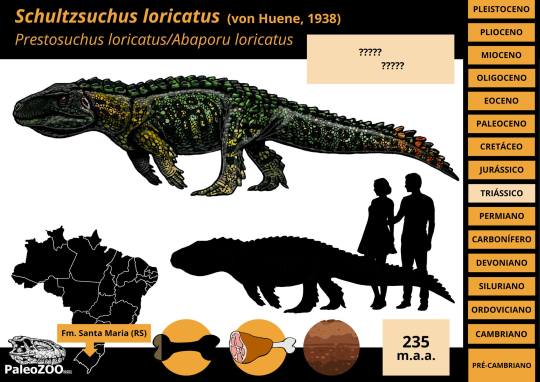
Garzapelta
Our last Triassic pseudosuchian and our only aetosaur of the year came to us in the form of Garzapelta muelleri (Mueller's Garza County Shield). It comes from the Late Triassic (Norian) Cooper Canyon Formation of, you guessed it, Garza County, Texas. As an aetosaur, the osteoderms are already regarded as diagnostic, tho unlike some other recent examples there is a little more material to go off from. It's still primarily osteoderms, but at least a good amount and even some ribs.
Artwork by Márcio L. Castro

Ophiussasuchus
Our only Jurassic newcommer is Ophiussasuchus paimogonectes (Paimogo Beach Swimmer Portuguese Crocodile), but arguably you couldn't find a better posterchild for Jurassic crocodyliforms. This new lad is a goniopholidid from the Kimmeridgian to Tithonian Lourinhã Formation, yup, Europe's Morrison. It's anatomy is perhaps not the most exciting, like other goniopholidids it had a flattened, very crocodilian-esque snout and was likely semi-aquatic like its relatives.
Artwork by @manusuchus and Joschua Knüppe
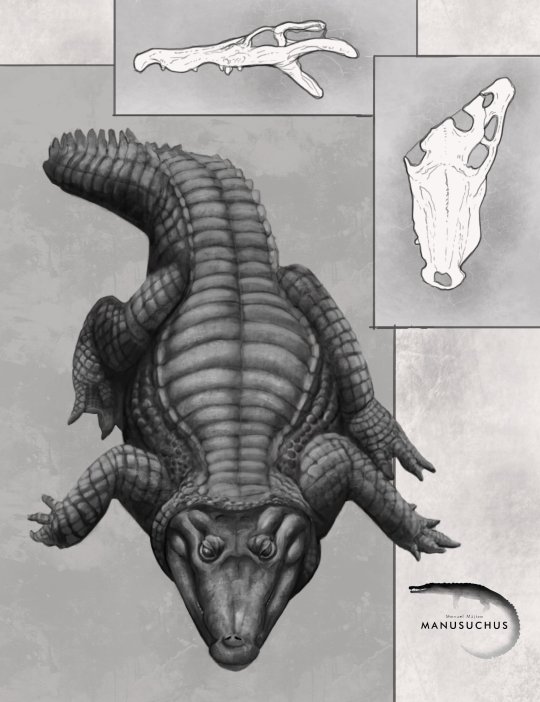

Enalioetes
Another quintessential group of Jurassic crocodyliforms are the metriorhynchoids, however, 2024's only new addition to this clade was actually Cretaceous, specifically from the earliest Cretaceous (Valanginian) of Germany. Like Schultzsuchus, Enalioetes schroederi (Schroeder's Sea Dweller) is new in name only, as fossil material has been found at the latest in 1918 and given the name Enaliosuchus "schroederi" in 1936. This kickstarted a whole series of taxonomic back and forth until the recent redescriptoin finally just gave it a new name and settled things (for now). Looking back I realize that I really need to take the time and fix up the Wikipedia page. Tho I've written its current status, I was kinda limited by being on vacation and never dived into the description section.
Artwork by Joschua Knüppe and Jackosaurus


Varanosuchus
Another Early Cretaceous crocodyliform is Varanosuchus sakonnakhonensis (Monitor Lizard Crocodile from the Sakon Nakhon Province), described from Thailand's Sao Khua Formation. It lived around the same time as Enalioetes, but otherwise couldn't have been more different. Where Enalioetes was fully marine, Varanosuchus was more a land dweller as evidenced by the deep skull and long, slender legs. At the same time, some other features, like its more robust limbs compared to its kin, might suggest that Varanosuchus could have still spent some time in the water like some modern lizards. Tho one might be reminded of Parvosuchus from earlier, Varanosuchus is a much more recent example of small terrestrial croc-relatives, the atoposaurids, which are much closer to todays crocodiles and alligators.
Artwork once again by Manusuchus

Araripesuchus manzanensis
Yet another example of a small, gracile land "crocodile" comes to us in the form of Araripesuchus manzanensis (Araripe Basin Crocodile from the El Manzano Farm). And once again, it belonged to a completely different group, this time the notosuchian family Uruguaysuchidae. Now Araripesuchus is well known as a genus, in part due to the work of Paul Sereno and Hans Larsson (who popularized the names "dog croc" and "rat croc" for two species). Tangent aside, A. manzanensis is known from the upper layers of Argentina's Candeleros Formation, corresponding to the Cenomanian (earliest Late Cretaceous). The same locality also yielded A. buitreraensis, from which A. manzanensis can be distinguished on account of its blunt molariform teeth in the back of its jaw. This dentition, which corresponds to a durophageous diet of hardshelled prey, could explain how it coexisted with the related A. buitrensis at the same locality, allowing the two to occupy different niches. There is a neat little animation done for this animal you can watch here.
Artwork by Gabriel Diaz Yantén

Caipirasuchus catanduvensis
We're staying in South America but moving to Brazil's Adamantina Formation for our next entry: Caipirasuchus catanduvensis (Caipiras Crocodile from Catanduva). This one is a little more recent, tho the age of the Adamantina Formation is a bit of a mess far as I can tell, ranging anywhere from the Turonian to the Maastrichtian. One could also argue that C. catanduvensis is part of the "lanky small croc club" that Parvosuchus, Varanosuchus and A. manzanensis belong to, but I feel that the very short snout helps it stand out from that bunch more easily. Anyhow, Caipirasuchus catanduvensis is a member of Sphagesauridae, related to Armadillosuchus, and herbivorous. What's really interesting tho is that the internal anatomy suggests the presence of resonance chambers not unlike that of hadrosaurs, possibly suggesting that these animals were quite vocal. This could also explain why baurusuchids appear to have had very keen hearing.
Artwork by Joschua Knüppe and Guilherme Gehr


Epoidesuchus
We're staying in the Adamantina Formation for our last Mesozoic croc of the year, Epoidesuchus tavaresae (Tavares' Enchanted Crocodile). Tho also a Notosuchian like Araripesuchus and Caipirasuchus, this one belongs to the family Itasuchidae (or the subfamily Pepesuchinae depending on who you ask), which stand out as being rare examples of semi-aquatic members of this otherwise largely terrestrial group. Epoidesuchus was fairly large for its kin and had long, slender jaws. Like I said, Epoidesuchus and its relatives were likely more semi-aquatic than other notosuchians, something that might explain the relative lack of semi-aquatic neosuchians across Gondwana. They aren't absent mind you, but noticably rarer than they are in the northern hemisphere.
Artwork by Guilherme Gehr

And thus we move into the Cenozoic and towards the end our or little list. From here on out, say goodbye to Notosuchians or other weird crocodylomorphs and get ready for Crocodilia far as the eye can see.
Ahdeskatanka
The first Cenozoic croc we got is Ahdeskatanka russlanddeutsche (Russian-German Alligator), which despite its name comes from North Dakota, specifically the Early Eocene Golden Valley Formation. Ahdeskatanka is similar to many early alligatorines like Allognathosuchus in being small with rounded, globular teeth that suggest that it fed on hardshelled prey. This would have definitely helped avoid competition in the Golden Valley Formation, which also housed a second, similar form not yet named, a large generalist with a V-shaped snout similar to Borealosuchus and the generalized early caiman Chrysochampsa, also large but with a U-shaped snout.
Artwork by meeeeeeee

Asiatosuchus oenotriensis
We had an alligatoroid, so now its time for a crocodyloid. Asiatosuchus has been recognized from the Late Eocene Duero Basin of Spain for a while now, but now we have a name: Asiatosuchus oenotriensis (Asian Crocodile Belonging To The Land Of Wine). Asiatosuchus is a complex genus, most often not really forming a monophyletic clade and likely representing several distinct or at least successive taxa that form the "Asiatosuchus-like complex". Within this complex, A. oenotriensis is thought to have been close-ish to Germany's Asiatosuchus germanicus.
Artwork by Manusuchus

Sutekhsuchus
Rounding out the trio of major crocodilian clades is Sutekhsuchus dowsoni (Set's Crocodile/God of Deception Crocodile), representing our only gavialoid of the year. Originally described as Tomistoma dowsoni in 1920 based on fossil remains from the Miocene of Egypt, Sutekhsuchus has been at times regarded as distinct and at other times lumped into Tomistoma lusitanica. It was one of several early gavialoids to inhabit the coast of the Tethys during the Miocene and appears to have been most closely related to the genus Eogavialis, clading together just outside of the American and Asian gharials. A fun little personal anecdote, I prematurely learned about this one due to a friend highlighting the name in a study on Eogavialis. Never having heard of "Sutekhsuchus" I took to google scholar, where I found a single result: a reference to the then unpublished description, which naturally I ended up eagerly awaiting.
Artwork by Manusuchus and Joschua Knüppe
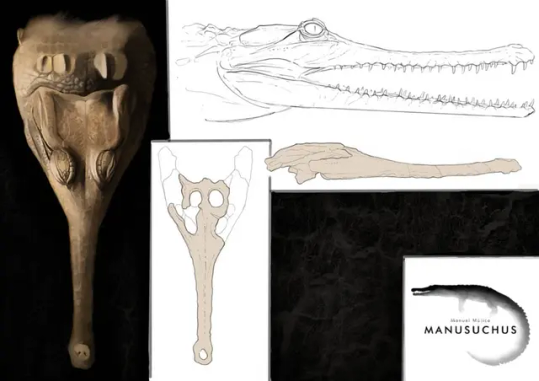

Paranacaiman
Two more and we're done. First, completely arbitrarily, Paranacaiman bravardi (Bravard's Caiman from Parana) from the Miocene Ituzaingo Formation of Argentina. Material of this genus has originally been referred to Caiman lutescens, described in 1912 but now considered a nomen dubium. Paranacaiman is known from limited material only, just the skull table, but that would indicate a "huge" animal. My personal scaling recovered a size of almost 5 meters in length, similar to large black caimans today.
Once again, credit to me

Paranasuchus
Last but not least, Paranasuchus gasparinae (Gasparini's Crocodile from Parana). Coming from the same deposits as Paranacaiman, this one too has been known as a species of Caiman for some time before being assigned its own genus, though it at least got to retain its old species name. Alas, I have not scaled it myself, tho its material is at least more extensive than that of Paranacaiman, including even parts of the snout. A little nitpick because I don't have much to say, but I personally think the name was ill conceived. On its own both Paranacaiman and Paranasuchus are fine names don't get me wrong, but together, coined by the same authors in the same study no less, they strike me as needlessly confusing to non experts. Both are caimans, both are from Parana, so the distinction between "Parana Caiman" and "Parana Crocodile" is entirely arbitrary and doesn't really distinguish them. Not helped by the fact that they are even closely related in the original description. Other than that tho another good addition to our understanding of fossil crocs.
No artwork on this one, but fossil material from Bona et al. 2024
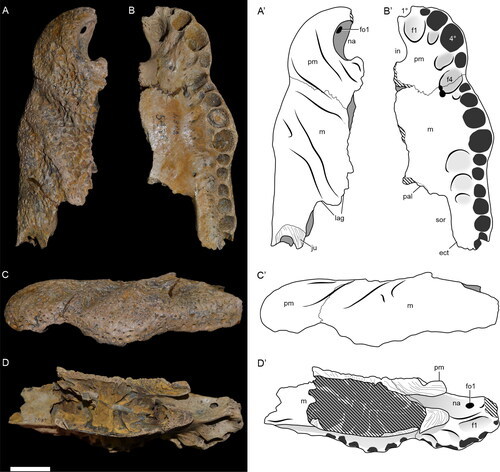
And that wraps up 2024. I hope This post, or my posts throughout the year or even my work on Wikipedia has helped to make these fascinating animals just a little bit more approachable and a massive thanks to all the artists who took their time to create fantastic pieces featuring these incredible animals. Special shout outs to Manusuchus, who diligently illustrated a lot of the featured animals and Joschua Knüppe, who had to listen to me suggest Ahdeskatanka every Sunday for about two months straight now.
Fossil Crocs of 2023
Fossil Crocs of 2022
#paranasuchus#paranacaiman#ahdeskatanka#sutekhsuchus#ophiussasuchus#epoidesuchus#caipirasuchus#araripesuchus#enalioetes#parvosuchus#benggwigwishingasuchus#schultzsuchus#garzapelta#varanosuchus#paleontology#prehistory#palaeoblr#long post#fossil crocs of 2024#paleo#paleonotlogy#crocodilia#crocodylomorpha#pseudosuchia#fossils#2024
234 notes
·
View notes